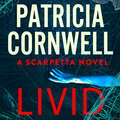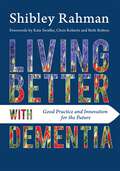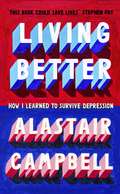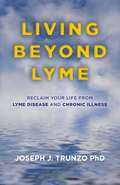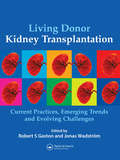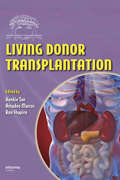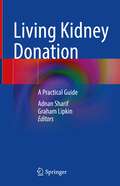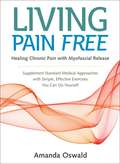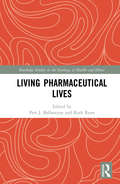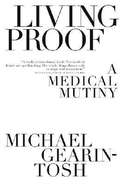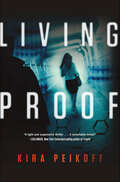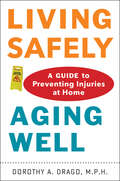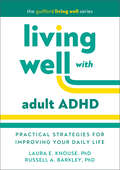- Table View
- List View
Livid: The new Kay Scarpetta thriller from the No.1 bestseller (Kay Scarpetta #26)
by Patricia CornwellTHE THRILLING NEW KAY SCARPETTA MYSTERY FROM THE #1 GLOBAL BESTSELLER'I'M STILL SEEING STARS . . . KAY SCARPETTA IS THE SAME GRUMPY, WONDERFUL, RIVETING PERSONALITY SHE'S ALWAYS BEEN AND SHE'S ONLY GETTING BETTER WITH TIME' JAMES PATTERSONMurder and mayhem. Scarpetta is back, and she's racing against the clock . . .Chief medical examiner Kay Scarpetta is the reluctant star witness in a sensational murder trial when she receives shocking news. The judge's sister has been found dead. At first glance, it appears to be a home invasion, but then why was nothing stolen, and why is the garden strewn with dead plants and insects?Although there is no apparent cause of death, Scarpetta recognizes tell-tale signs of the unthinkable, and she knows the worst is yet to come. The forensic pathologist finds herself pitted against a powerful force that returns her to the past, and her time to catch the killer is running out . . .'RIVETING' THE TIMES'CORNWELL KNOWS HOW TO CRAFT A MEAN PAGE-TURNER AND LIVID IS NO EXCEPTION' TELEGRAPH'ONE OF THE BEST CRIME WRITERS WRITING TODAY' GUARDIAN'GRIPPING . . . SOUND THE KLAXON, DR KAY SCARPETTA IS BACK' HEAT'ASTONISHING . . . THIRTY YEARS ON, THERE'S STILL NO OTHER CRIME WRITER LIKE HER' SUNDAY TIMES
Living Better with Dementia: Good Practice and Innovation for the Future
by Chris Roberts Beth Britton Kate Swaffer Shibley RahmanWhat do national dementia strategies, constantly evolving policy and ongoing funding difficulties mean for people living well with dementia? Adopting a broad and inclusive approach, Shibley Rahman presents a thorough critical analysis of existing dementia policy, and tackles head-on current and controversial topics at the forefront of public and political debate, such as diagnosis in primary care, access to services for marginalised groups, stigma and discrimination, integrated care, personal health budgets, personalised medicine and the use of GPS tracking. Drawing on a wealth of diverse research, and including voices from all reaches of the globe, he identifies current policy challenges for living well with dementia, and highlights pockets of innovation and good practice to inform practical solutions for living better with dementia in the future. A unique and cohesive account of where dementia care practice and policy needs to head, and why, and how this can be achieved, this is crucial reading for dementia care professionals, service commissioners, public health officials and policy makers, as well as academics and students in these fields.
Living Better: How I Learned to Survive Depression
by Alastair CampbellTHE SUNDAY TIMES BESTSELLERLast Christmas I almost killed myself. Almost. I've had a lot of almosts. Never gone from almost to deed. Don't think I ever will. But it was a bad almost. Living Better is Alastair Campbell's honest, moving and life affirming account of his lifelong struggle with depression. It is an autobiographical, psychological and psychiatric study, which explores his own childhood, family and other relationships, and examines the impact of his professional and political life on himself and those around him. But it also lays bare his relentless quest to understand depression not just through his own life but through different treatments. Every bit as direct and driven, clever and candid as he is, this is a book filled with pain, but also hope -- he examines how his successes have been in part because of rather than despite his mental health problems -- and love. We all know someone with depression. There is barely a family untouched by it. We may be talking about it more than we did, back in the era of 'boys don't cry' - they did you know - and when a brave face or a stiff upper lip or a best foot forward was seen as the only way to go. But we still don't talk about it enough. There is still stigma, and shame, and taboo. There is still the feeling that admitting to being sad or anxious makes us weak. It took me years, decades even to get to this point, but I passionately believe that the reverse is true and that speaking honestly about our feelings and experiences (whether as a depressive or as the friend or relative of a depressive) is the first and best step on the road to recovery. So that is what I have tried to do here.
Living Better: How I Learned to Survive Depression
by Alastair CampbellAlastair Campbell's honest, moving and life affirming account of his lifelong struggle with depressionLast Christmas I almost killed myself. Almost. I've had a lot of almosts. Never gone from almost to deed. Don't think I ever will. But it was a bad almost. Living Better is Alastair Campbell's honest, moving and life affirming account of his lifelong struggle with depression. It is an autobiographical, psychological and psychiatric study, which explores his own childhood, family and other relationships, and examines the impact of his professional and political life on himself and those around him. But it also lays bare his relentless quest to understand depression not just through his own life but through different treatments. Every bit as direct and driven, clever and candid as he is, this is a book filled with pain, but also hope -- he examines how his successes have been in part because of rather than despite his mental health problems -- and love. We all know someone with depression. There is barely a family untouched by it. We may be talking about it more than we did, back in the era of 'boys don't cry' - they did you know - and when a brave face or a stiff upper lip or a best foot forward was seen as the only way to go. But we still don't talk about it enough. There is still stigma, and shame, and taboo. There is still the feeling that admitting to being sad or anxious makes us weak. It took me years, decades even to get to this point, but I passionately believe that the reverse is true and that speaking honestly about our feelings and experiences (whether as a depressive or as the friend or relative of a depressive) is the first and best step on the road to recovery. So that is what I have tried to do here. 'I thought I knew everything there was to know about Alastair but LIVING BETTER reveals so much more' TONY BLAIR.(P) 2020 Hodder & Stoughton Ltd
Living Beyond Lyme: Reclaim Your Life From Lyme Disease and Chronic Illness
by Joseph J. TrunzoLiving Beyond Lyme helps patients side-step the often frustrating controversy surrounding Lyme disease. This book instead focuses on living meaningfully, using mindfulness and Acceptance & Commitment Therapy (ACT) approaches. Whether it is acute or chronic, Lyme disease causes suffering, and ACT, an evidence-based, scientifically driven approach, can help people change their experience of their illness.
Living Candida-Free: 100 Recipes and a 3-Stage Program to Restore Your Health and Vitality
by Ricki Heller Andrea NakayamaDiscover the hidden epidemic that may be making you sick--and a delicious food- based program that can help you heal Candida yeast is a normal part of a healthy digestive tract. But once the body's internal balance of "good" bacteria and other organisms has been upset, candida can grow out of control, resulting in a host of other symptoms from chronic fatigue and digestive disorders to skin conditions and allergies. The good news is that the key to rebalancing that internal environment just may reside in your kitchen. Health and wellness blogger Ricki Heller and functional nutritionist Andrea Nakayama demystify this challenging condition and share a food-based program to help you get your body back on track. A practical, accessible guidebook, Living Candida-Free offers: a customizable three-stage program, with an optional Fast Track plan strategies to transition to eating the anti-candida way with ease tips for stocking your pantry, with lists of key ingredients and substitutions 100 satisfying, plant-based recipes for every meal--including dessert!
Living Data: Making Sense of Health Biosensing
by Celia Roberts Adrian MackenzieAs individuals increasingly seek ways of accessing, understanding and sharing data about their own bodies, this book offers a critique of the popular claim that ‘more information’ equates to ‘better health’. In a study that redefines the public, academic and policy related debates around health, bodies, information and data, the authors consider the ways in which the phenomenon of self-diagnosis has created alternative worlds of knowledge and practises which are often at odds with professional medical advice. With a focus on data that concerns significant life changes, this book explores the potential challenges related to people’s changing relationships with traditional health systems as access to, and control over, data shifts.
Living Donor Advocacy
by Jennifer SteelThe inadequate supply of organs in the United States and other countries continues to drive the reliance on living donor transplantation. In 2000, representatives of the transplant community convened for a meeting on living donation in an effort to provide guidelines to promote the welfare of living donors. The consensus statement that resulted from this meeting recommended that transplant centers retain an Independent Living Donor Advocate (ILDA) to focus on the best interest of the donor. A decade later, nearly every transplant center in the United States, performing living donor surgeries, has incorporated an ILDA into their living donor screening and/or evaluation process Living Donor Advocate provides an overview of living donation and its risks, ethical challenges and future developments, as well as details about the role a Living Donor Advocate plays in the transplantation process. This book will interest health professionals across various disciplines and patients undergoing transplantation or living donor surgery.
Living Donor Kidney Transplantation: Current Practices, Emerging Trends and Evolving Challenges
by Jonas Wadström Robert S GastonLiving donor kidney (LDK) transplantation has become the definitive approach to the treatment of end-stage renal failure, providing a better quality of life and the best opportunity for survival when compared with dialysis or transplantation from a deceased donor. A timely compendium of the modern day practice of LDK transplantation from a group of
Living Donor Transplantation
by Henkie P. Tan Amadeo Marcos Ron ShapiroEdited by leaders at one of the acclaimed transplant institutions in the United States, this reference covers all aspects of living donor solid organ and cellular transplantation in current clinical practice, including the kidney, liver, pancreas, lung, small bowel, islet, and hematopoietic stem cell transplantation. Detailed, engaging, and organ-
Living Kidney Donation: A Practical Guide
by Adnan Sharif Graham LipkinThis book provides a guide to the principles and practice of living kidney donation. Concise and well-structured chapters discuss the ethics of living kidney donation, medical evaluation of kidney donors, donor nephrectomy surgery, and long-term outcomes of transplantation, along with broader medical issues related to cardiology, surgery, and anesthesia. Living Kidney Donation: A Practical Guide aims to give readers the essential information required for undertaking living kidney donation and is relevant to nephrologists, transplant surgeons, and healthcare professionals working in renal transplantation.
Living Kidney Donation: Best Practices in Evaluation, Care and Follow-up
by Edgar V. Lerma Krista L. Lentine Beatrice P. ConcepcionThis book provides a complete guide to the evaluation, care, and follow-up of living kidney donors. Living donor kidney transplantation is established as the best treatment option for kidney failure. However, despite the tremendous benefits of living donation to recipients and society, the outcomes and optimal care of donors themselves have received relatively less attention. Fortunately, things are changing – including recent landmark developments in living donor risk assessment, policy and guidance. This volume offers authoritative, evidence-based guidance on the full range of clinical scenarios encountered in the evaluation and care of living kidney donors. The approach to key elements of risk assessment, ethical considerations and informed consent is accompanied by recommendations for patient-centered care before, during, and after donation. Advocacy initiatives and policies to remove disincentives to donation and advance a defensible system of practice are also discussed. General and transplant nephrologists, as well as related allied health professionals, can look to this book as a comprehensive resource addressing contemporary clinical topics in the practice of living kidney donation.
Living Longer and Healthier at Older Ages: A Longitudinal Analysis of Chinese Oldest Old’s Health and Its Determinants (Advances in Studies of Aging and Health #3)
by Li ZhangThis book analyzes data from eight waves (1998, 2000, 2002, 2005, 2008, 2011-12, 2014 and 2018) of the Chinese Longitudinal Healthy Longevity Surveys (CLHLS) to explore how health status of the Chinese oldest old has changed over time and across birth cohorts. It also intends to investigate how period and birth cohorts have played a role in the associations between Chinese oldest old’s health and a variety of demographic, socioeconomic, and lifestyle factors. The book applies the age-period-cohort (APC) approach and constructs cross-classified random-effects models (CCREMs) to carry out the analyses. The oldest old’s health is measured by self-rated health (SRH), chronic diseases, cognitive function and subjective wellbeing which is indicated by positive and negative feeling scores. The results show that Chinese oldest old’s health status has changed over time and across birth cohorts. Significant period and cohort effects are shown when linking Chinese oldest old’s health to various demographic, socioeconomic and health lifestyle covariates. In general, period effects surpass the cohort effects. Particularly, the oldest old’s subjective wellbeing is more likely to be influenced by period than cohort effects. Period changes caused by social events, such as economic hardship and natural disasters, have left strong imprints on Chinese oldest old’s mental than physical health status. Based on these findings, the book highlights some important policy implications and points out future research directions to improve the current study. It provides an interesting read for researchers in gerontology and public health studies. It is also of interest to general audience, including practitioners in health care and policy makers who are interested in old age care and healthy aging policies.
Living Out Loud: Sports, Cancer, and the Things Worth Fighting For
by Brian Curtis Craig Sager Craig Sager IIThe beloved sportscaster recounts how he maintained a positive outlook on life in the face of battling leukemia in this moving and inspiring memoir.A New York Times Bestseller“Time is something that cannot be bought, it cannot be wagered with God, and it is not in endless supply. Time is simply how you live your life.” —Craig SagerThanks to an eccentric wardrobe filled with brightly colored suits and a love of sports that knows no bounds, Craig Sager is one of the most beloved and recognizable broadcasters on television. So when the sports world learned that he was diagnosed with acute myeloid leukemia (AML) there was an outpouring of love and support from everyone who was inspired by his colorful life and his fearless decision to continue doing the job he loved—despite being told that he would have only three-to-six months to live. Sager has undergone three stem cell transplants—with his son as the donor for two of them—and more than twenty chemotherapy cycles since his diagnosis.In Living Out Loud, Craig Sager shares incredible stories from his remarkable career and chronicles his heroic battle. Whether he’s sprinting across Wrigley Field mid-game as a college student with cops in pursuit, chasing down Hank Aaron on the field for an interview after Aaron broke Babe Ruth’s home run record, running with the bulls in Pamplona, or hunkering down to face the daunting physical challenges of fighting leukemia, Craig Sager is always ready to defy expectations, embrace life, and live it to the fullest.Including a foreword by Charles Barkley and with unique insight from his son Craig Sager II, this entertaining, honest, and introspective account of a life lived in sports reveals the enduring lessons Sager has learned throughout his career and reminds you that no matter what life throws at you, to always look at the bright side.
Living Pain Free: Healing Chronic Pain with Myofascial Release--Supplement Standard MedicalApproaches with Simple, Effective Exercises You Can Do Yourself (A\little Book Of Self Care Ser.)
by Amanda OswaldAn essential self-help guide to treatment of chronic pain based on myofascial release This indispensible self-help guide is for anyone suffering from chronic pain and struggling to understand why standard medical approaches have failed them. Taking a mind-body approach, the book clearly and simply explains how chronic pain develops, and why an understanding of fascia—the main connective tissue in the body—is the key to restoring pain-free movement and health. Author and myofascial release expert Amanda Oswald informs readers about the role of fascia in chronic pain and empowers them to help themselves through simple and effective self-care techniques, stretches, and exercises. Living Pain Free is a must-read for anyone experiencing chronic pain from conditions including migraines and headaches, repetitive strain injury (RSI), jaw (TMJ) pain, frozen shoulder, neck and back pain, chronic pelvic pain, scar tissue, and systemic pain conditions such as fibromyalgia, chronic fatigue, and myofascial pain syndrome. It will also benefit anyone interested in understanding chronic pain from a myofascial perspective.
Living Pharmaceutical Lives
by Kath Ryan Peri J. BallantyneIncreasingly, pharmaceuticals are available as the solutions to a wide range of human health problems and health risks, minor and major. This book portrays how pharmaceutical use is, at once, a solution to, and a difficulty for, everyday life. Exploring lived experiences of people at different stages of the life course and from different countries around the world, this collection highlights the benefits as well as the challenges of using medicines on an everyday basis. It raises questions about the expectations associated with the use of medications, the uncertainty about a condition or about the duration of a medicine regimen for it, the need to negotiate the stigma associated with a condition or a type of medicine, the need to access and pay for medicines and the need to schedule medicine use appropriately, and the need to manage medicines’ effects and side effects. The chapters include original empirical research, literature review and theoretical analysis, and convey the sociological and phenomenological complexity of ‘living pharmaceutical lives’. This book is of interest to all those studying and researching social pharmacy and the sociology of health and illness.
Living Proof: A Medical Mutiny
by Michael Gearin-ToshI was told I had cancer and that I must expect to die soon. Almost eight years later I still do my job and enjoy life. I have not had conventional treatment. Did my cancer simply disappear? Did I do nothing? Far from it. A number of things happened, some by accident, most by design. Michael Gearin-Tosh is diagnosed with cancer at the age of fifty-four. The doctors urge immediate treatment. He refuses. Intuitively, not on the basis of reason. But as the days pass, Gearin-Tosh falls back on his habits as a scholar of literature. He begins to probe the experts' words and the meaning behind medical phrases. He tries to relate what each doctor says -- and does not say -- to the doctor's own temperament. And the more questions he asks, the more adamant his refusal to be hurried to treatment. The delay is a high-risk gamble. He listens to much advice, especially that of three women friends, each with a different point of view, one a doctor. They challenge him. They challenge medical advice. They challenge one another. On no occasion do they speak with one voice. He also turns to unexpected guides within his own memory and in the authors he loves, from Shakespeare and Chekhov to Jean Renoir, Arthur Miller, and Václav Havel. In the end, he chooses not to have chemotherapy but to combat his cancer largely through nutrition, vitamin supplements, an ancient Chinese breathing exercise with imaginative visualizations, and acupuncture. No how-to book or prescriptive health guide, Living Proof is a celebration of human existence and friendship, a story of how a man steers through conflicting advice, between depression and seemingly inescapable rationalism, between the medicine he rejects and the doctors he honors. Clear-eyed and unflinching, Gearin-Tosh even includes his own medical history, "The Case of the . 005% Survivor"; explores general questions about cancer; and examines the role of individual temperament on medical attitudes, the choice of treatments, and, of course, survival.
Living Proof: A Thriller
by Kira PeikoffA thought-provoking thriller by debut author Kira Peikoff, Living Proof is a celebration of love and life that cuts to the core of a major cultural debate of our time.In 2027, destroying an embryo is considered first-degree murder. Fertility clinics still exist, giving hope and new life to thousands of infertile families, but they have to pass rigorous inspections by the United States Department of Embryo Preservation. Fail an inspection, and you will be prosecuted.Brilliant young doctor Arianna Drake seems to be thriving in the spotlight: her small clinic surpasses every government requirement, and its popularity has spiked—a sudden, rapid growth that leaves the DEP chief mystified. When he discovers Arianna's radical past as a supporter of an infamous scientist, he sends undercover agent Trent Rowe to investigate her for possible illegal activity.As Trent is pulled into Arianna's enigmatic world, his own begins to unravel. The secret he finally uncovers will deeply move him—and jeopardize them both. With the clock ticking her life away, he finds himself questioning everything he knows to be true, and then must summon the courage to take the greatest risk of all. Nothing less than human life—and a major scientific breakthrough—hang in the balance.At the Publisher's request, this title is being sold without Digital Rights Management Software (DRM) applied.
Living Safely, Aging Well: A Guide to Preventing Injuries at Home
by Dorothy A. DragoOlder adults can stay healthy longer by avoiding injury at home.As we age, our sense of balance and our vision, hearing, and cognition become less sharp. Aging-related changes greatly increase our risk of injury. In Living Safely, Aging Well, nationally recognized safety expert Dorothy A. Drago spells out how to prevent injury while cooking, gardening, sleeping, driving—and just walking around the house.In the first part of the book, Drago describes the causes of injuries by type—falls, burns, poisoning, and asphyxia—and explains how to decrease the risk of each. She then explores the home environment room by room, pointing out potential hazards and explaining how to avoid them, for example, by installing night lights, eliminating glass coffee tables, and using baby monitors. Lively line drawings make it easy for readers to visualize risks and implement prevention techniques. Living Safely, Aging Well pays special attention to hazards encountered by people with Alzheimer’s disease and other forms of dementia. A chapter devoted to health literacy helps people and caregivers make the best use of the medical care system and a chapter on driving helps evaluate when it is no longer safe to be behind the wheel.
Living Sensationally: Understanding Your Senses
by Winnie DunnHow do you feel when you bite into a pear... wear a feather boa... stand in a noisy auditorium... or look for a friend in a crowd? Living Sensationally explains how people's individual sensory patterns affect the way we react to everything that happens to us throughout the day. Some people will adore the grainy texture of a pear, while others will shudder at the idea of this texture in their mouths. Touching a feather boa will be fun and luxurious to some, and others will bristle at the idea of all those feathers brushing on the skin. Noisy, busy environments will energize some people, and will overwhelm others. The author identifies four major sensory types: Seekers; Bystanders; Avoiders and Sensors. Readers can use the questionnaire to find their own patterns and the patterns of those around them, and can benefit from practical sensory ideas for individuals, families and businesses. Armed with the information in Living Sensationally, people will be able to pick just the right kind of clothing, job and home and know why they are making such choices.
Living Stones of the Himalayas: Adventures of an American Couple in Nepal
by Thomas HaleSince 1970, the team of Thomas Hale and his wife, Cynthia, have struggled to serve God as medical doctors in the remote storybook kingdom of Nepal. In the process they have experienced both the hardships and the blessings of bringing Western medicine to people who distrust -- even fear -- ideas differing from their own. n the same process, by their selfless love and caring, they have gained the affection and trust of their Nepali patients and neighbors. In this true story, the faith and humility of doctors Tom and Cynthia Hale are matched by the beguiling personality and character of the Nepalese people, the majority of whom are subsistence farmers who share much in common with the poor of all developing countries. Living Stones of the Himalayas, like its predecessors Don't Let the Goats Eat the Loquat Trees and On the Far Side of Liglig Mountain, is a graphic portrait of the human condition and the growing pains of the unique and intriguing land of Nepal with its astonishing beauty that exists side by side with: - faith and superstition - sickness and death - ancient traditions and twentieth-century innovations - courage and joie de vivre Living Stones of the Himalayas is a fascinating account of everyday and sometimes incredible experiences mingled with humor, understanding, and love for humanity. Reading it will transport you to one of the most enchanting lands away -- first class.
Living The Reiki Way: Traditional principles for living today
by Penelope QuestPractising Reiki is not simply about healing others - it is also about healing yourself and growing spiritually. In LIVING THE REIKI WAY, Penelope Quest offers practical and spiritual guidance on how you can absorb the six key Reiki principles into your everyday life. They are:* Live in the now* Live without anger* Live without worry* Live with gratitude* Live with kindness* Work honestly and diligentlyBy encouraging us to live by these principles in the present, Penelope Quest will help us to achieve long-term happiness and contentment.
Living Under the Threat of Earthquakes: Short and Long-term Management of Earthquake Risks and Damage Prevention in Nepal (Springer Natural Hazards)
by Rameshwar Adhikari Jörn H. Kruhl Uwe E. DorkaThis book addresses earthquakes, with a special focus on the Ghorka earthquake, which struck parts of central Nepal in April 2015. Drawing on this disastrous event, it closely examines various aspects of earthquakes in contributions prepared by international experts. The topics covered include: the geological and geophysical background of seismicity; a detailed inventory of the damage done by the earthquake; effective damage prevention through earthquake-safe buildings and settlements; restoration options for world-heritage buildings; strategies for providing technical and medical relief and, lastly, questions associated with public life and economy in a high-risk seismic zone. Combining perspectives from various fields, the book presents the state of the art in all earthquake-related fields and outlines future approaches to risk identification, damage prevention, and disaster management in all parts of society, administration, and politics in Nepal. Beyond the specific disaster in Nepal, the findings presented here will have broader implications for how societies can best deal with disasters.
Living Well with Adult ADHD: Practical Strategies for Improving Your Daily Life (The Guilford Living Well Series)
by Russell A. Barkley Laura E. KnouseImagine an ADHD toolkit filled with tried-and-true skills that empower you to be more focused and productive--and to "hack" daily life so your strengths can shine. That's exactly what expert therapist Laura E. Knouse and preeminent authority Russell A. Barkley offer in this friendly guide. In short, engaging chapters, you get a menu of science-based strategies and resources for getting organized, completing tasks from start to finish, managing time, regulating your emotions and impulses, and addressing common relationship problems faced by adults with ADHD. Drs. Knouse and Barkley share ideas you can use every day, complete with checklists, self-coaching tips, helpful links, and downloadable forms.
Living Well with Anxiety: What Your Doctor Doesn't Tell You . . . That You Need to Know (Living Well)
by Carolyn Chambers ClarkA complete guide to the side-effects and treatments for anxiety disordersHigh anxiety is an unfortunate byproduct of this world, and for approximately 20 million American adults a year, anxiety becomes a debilitating part of their lives. The psychological can become physical, causing dizziness, stammering, heart palpitations, trembling, shaking, and other symptoms. Unlike other books on anxiety disorders, Living Well with Anxiety offers a holistic approach to minimizing anxiety, presenting both conventional psychiatric and psychological approaches to anxiety conditions, as well as patient anecdotes, and nutrition, herbal, environmental, exercise and other healing measures to combat this disorder. Living Well with Anxiety contains helpful advice for a wide range of anxiety disorders, including social anxiety disorder, panic disorder, obsessive compulsive disorder and various phobias that cause anxiety. With a comprehensive resource section that contains websites, doctors, and helpful articles, this book, like all of the titles in the successful Living Well series, offers positive and far-reaching solutions to building a healthier life, both emotionally and physically.
